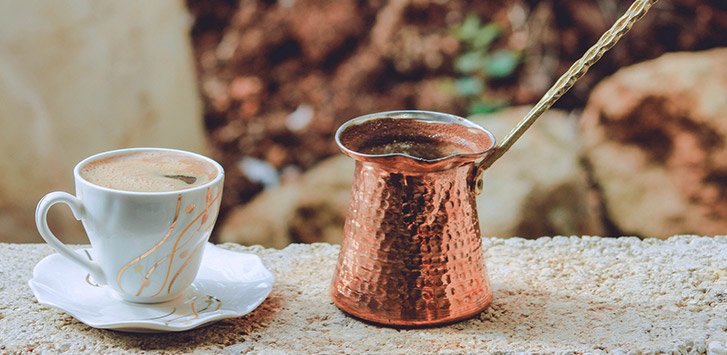Turkish coffee, a beverage steeped in tradition, is known for its strong and unique flavor. It is also referred to as “jezva” or “ibrik,” terms that vary based on the diameter of the pot’s neck. This article will expand on the intricacies of making Turkish coffee, including the choice of brewing material, heat source, coffee proportions and grinds, preparation, and serving.
Choice of Brewing Material
The material of the coffee pot, typically a jezva or ibrik, is crucial in determining the quality of the brew. Copper is the most preferred material due to its excellent thermal conductivity and resistance to oxidation. Many copper jezvas are lined with silver, which further minimizes oxidation, thus preserving the coffee’s flavor. Ceramic pots are also used but are less efficient as they retain heat longer, potentially affecting the brewing process. Aluminum, while an option, is the least favorable due to its slow heat transfer, risking uneven brewing and potential burning of the coffee grounds.
Heat Source
Traditional Turkish coffee brewing is often done on sand. This method allows for uniform heating, as the sand evenly distributes heat around the jezva. Adjustments to the brewing speed can be made by moving the pot in the sand or adding fresh sand to it. Gas burners are also suitable for brewing Turkish coffee as they heat both the bottom and sides of the pot effectively. Electric stoves, while usable, are less ideal since they primarily heat the pot’s bottom, leading to inconsistent brewing.
Proportions and Grinds
The ideal jezva size ranges between 100-200 ml. The standard coffee-to-water ratio is 8.5-9 grams of coffee per 100 ml of water. Turkish coffee requires an extremely fine grind, akin to dust, which may necessitate a professional hand grinder with metal millstones for optimal results.
Preparation
Begin with room temperature water. Pour it into the jezva and place the pot in the sand (or on your chosen heat source). Stir once. To expedite the process, you can move the jezva around in the sand. Watch for the foam to rise, indicating the release of carbon dioxide from the water. The appearance of a thick foam suggests the onset of boiling, signalling the end of the brewing process.
Serving
Turkish coffee is traditionally served hot. However, it is advisable to let it cool to around 60-70 degrees Celsius before drinking. This cooling period typically takes about three minutes and allows the flavors to settle, offering a more enjoyable experience.
This process of making Turkish coffee is not just about brewing a cup of coffee; it’s an art form that combines tradition, skill, and a deep understanding of the coffee-making process. The result is a rich, aromatic, and deeply satisfying experience that is revered in coffee cultures worldwide.



Leave a Reply